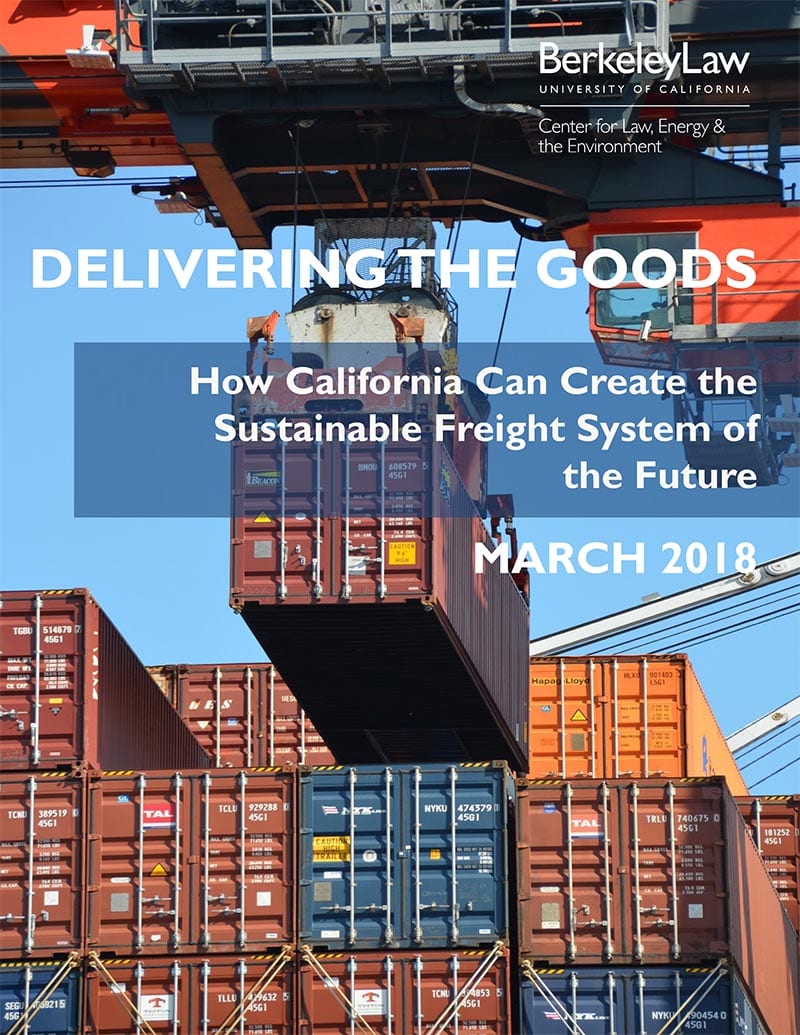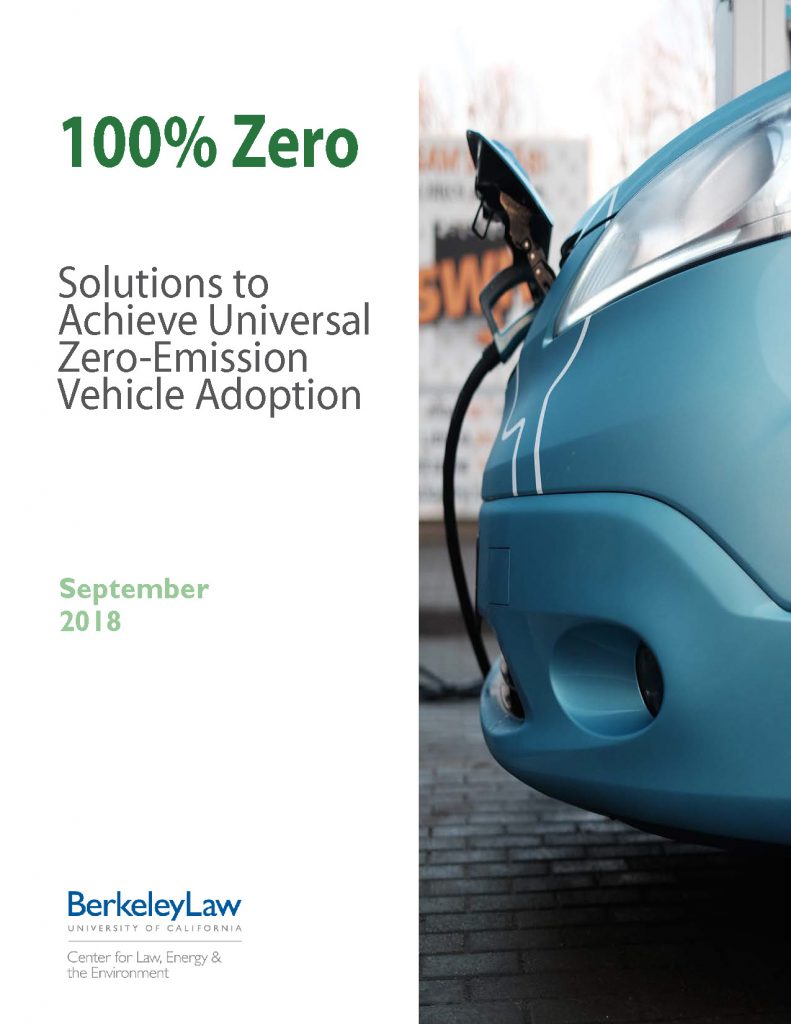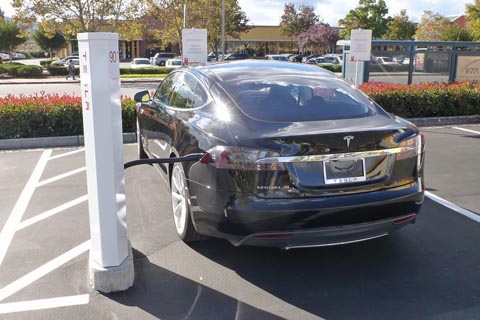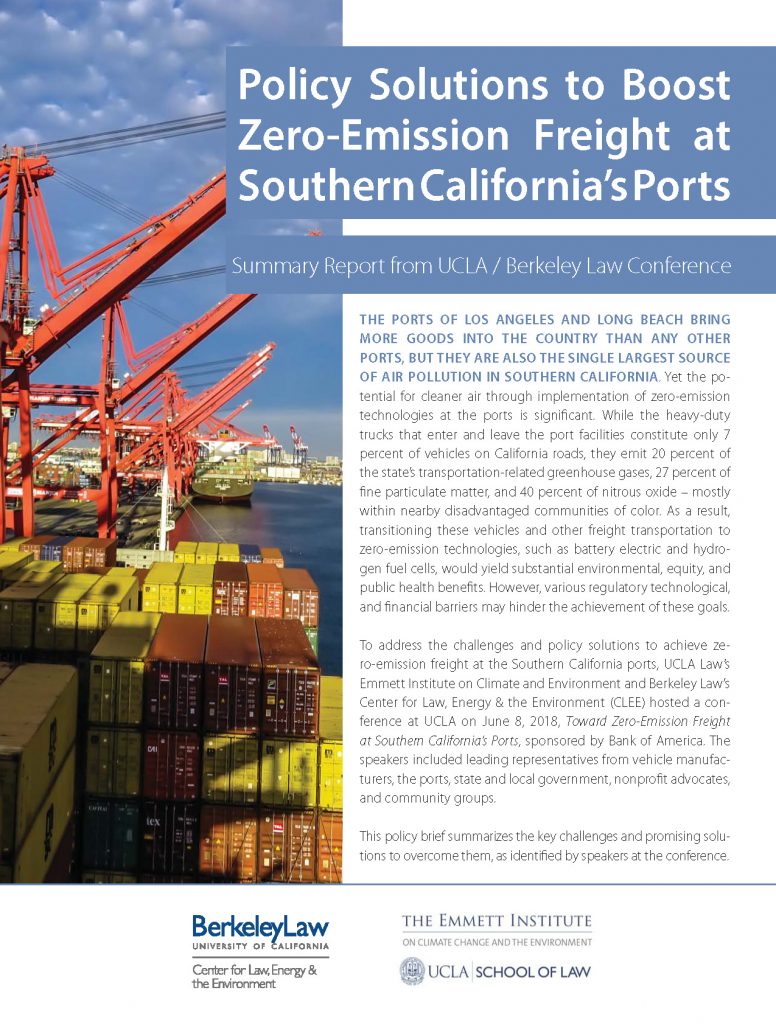The HHLA Container Terminal Altenwerder (CTA) in Hamburg, Germany, features an automated handling facility using low and zero-emission equipment, similar to the Port of Long Beach. This video shows the cutting-edge technology and attendant environmental benefits:
It’s easy to see why labor groups fear the automation technology, as no workers are now needed in this facility. And it also points to the continued need to deploy zero-emission trucks, as once the cargo leaves the facility, it’s still carried by dirty trucks polluting nearby neighborhoods.
 The critics are out for California’s groundbreaking climate and energy goals. Cal Matters (and former Sacramento Bee) columnist Dan Walters criticizes the state’s new 100% renewable energy and carbon neutrality goals by 2045:
The critics are out for California’s groundbreaking climate and energy goals. Cal Matters (and former Sacramento Bee) columnist Dan Walters criticizes the state’s new 100% renewable energy and carbon neutrality goals by 2045:
It’s theoretically possible to build enough solar and windmill farms to [achieve a 100% greenhouse gas-free grid], albeit at immense cost, but there’s a corollary problem. They mostly generate during daylight hours, so having their power available 24 hours a day would require huge amounts of storage, presumably in massive battery banks.
Battery technology hasn’t advanced to that stage yet, at least at a viable cost. After Brown signed the 2045 legislation, Moody’s, the big credit rating organization, called it a “credit negative” for the state’s electrical utilities, citing battery storage capacity.
Walters fails to acknowledge here that “energy storage” to capture surplus renewables includes a diverse array of technologies beyond just batteries. Furthermore, with the carbon-free target date of 2045 still a generation away, industry has plenty of time to innovate in response to this challenge. We’ve already seen battery prices decline about 80% in 10 years. So why use today’s numbers to criticize a critical long-term mandate?
Walters then attacks California’s zero-emission vehicle (ZEV) goals:
There are only about 200,000 ZEVs on the road now, so replacing all gasoline- and diesel-fueled cars at $30,000 each by 2045 would cost California motorists (and/or taxpayers) about a trillion dollars, or an average of $37 billion a year.
Again, Walters refuses to assume any cost decreases in the price of ZEVs by 2045, or the availability of inexpensive used vehicles in the meantime. This flies in the face of price trends to date. Walters also neglects to mention the fuel and maintenance savings from these vehicles.
Finally, he criticizes the push for electrification of transportation based on how much more power the state will need to deliver:
Driving 100 miles in a ZEV consumes 30 kilowatt-hours of electric power, according to the federal government. Therefore, assuming they were still traveling 330 billion miles each year, recharging 30 million ZEVs would expand annual electric power consumption from 300 terawatt-hours to at least 400, and that extra juice also would have to come from solar, wind and other renewable resources.
Moreover, since the ZEVs would be mostly recharged at night, the carbon-free electrical grid would need even more battery storage to keep them running.
Fun numbers, indeed.
Walters omits some key details. First, the state also has a goal of increasing energy efficiency, including a doubling of efficiency in existing buildings by 2030, which would reduce energy demand overall. Second, state leaders are trying to reduce driving miles per capita by investing in more transit, walking and biking infrastructure, while attempting to build more homes close to jobs and transit. If successful by 2045, driving miles would decrease, along with projected energy demand. Finally, state regulators are pushing for electricity rates that will encourage more daytime charging, to avoid the problem Walters cites.
Overall, Walters’ entire analysis fails to factor in the cost of inaction. What about the public health impacts of more pollution? What about the cost of addressing climate impacts, such as more fires, sea level rise, and droughts?
Walters raises some legitimate questions, but his analysis in response is selective and incomplete.
While the U.S. government retreats on this critical clean technology, China continues its ascent, per August sales figures [E&E News]:
Sales of pure-electric cars rose 31.7 percent from a year ago to 72,000 units. Sales of gasoline-electric hybrids jumped 130.8 percent to 28,000 vehicles.
Beijing is in the midst of a multibillion-dollar campaign to promote electric car development in hopes of creating a profitable new industry. Automakers are rolling out dozens of electrics but still rely on sales of gasoline-powered models for their profits.
In August, Nissan Motor Co. began production of its first electric sedan designed for China. The Sylphy Zero Emission, based on Nissan’s Leaf, is the first of dozens of lower-cost electrics being developed for China by General Motors, Volkswagen and other global automakers.
From a climate perspective, it’s a good thing that China is throwing its manufacturing muscle toward clean cars. It means cheap EVs will be abundant in our near future.
But from a U.S. economic competitiveness standpoint, it’s a major surrender. While California is continuing its leadership on electric vehicles, the future of transportation increasingly looks like it will mostly involve inexpensive Chinese models plying America’s roads.
 Tonight on City Visions, I’ll report on the highlights from the Global Climate Action Summit last week in San Francisco. Among the many major announcements were California’s new commitments to a 100% clean electricity grid and to carbon neutrality by 2045.
Tonight on City Visions, I’ll report on the highlights from the Global Climate Action Summit last week in San Francisco. Among the many major announcements were California’s new commitments to a 100% clean electricity grid and to carbon neutrality by 2045.
As the largest emitter of greenhouse gases in California, how will the transportation industry respond to the challenge to become fossil free? Join my co-host Joseph Pace and these guests:
- Sam Arons, Director of Sustainability at Lyft
- Holly Gordon, Sustainability Group Manager at BART
- Ellen Greenberg, Deputy Director for Sustainability at Caltrans
- Jonathan Levy, VP of Strategic Initiatives at EVgo
Tonight’s show is the second in our three-part series on climate change. You can listen live on 91.7FM in the San Francisco Bay Area or on the web. Please tune in and ask questions!
The Breakthrough Blog hosted an on-line Q&A with various experts on trends in freight in 2018. This issue is important because freight is a contributor to greenhouse gas emissions as well as harmful air pollution. In addition to me, respondents included:
- Doug Mueller: Breakthrough President and CEO
- Brooks Bentz: President, Breakthrough Supply Chain
- Jeremy Becker: Managing Director, Breakthrough Supply Chain
- Rep. Mike Gallagher (R-Wis.): Congressman for Wisconsin’s 8th District
- Matt Muenster: Senior Manager, Breakthrough Applied Knowledge
- Jenny Vander Zanden: Vice President, Breakthrough Fuel Recovery
 Doug Mueller kicked off the responses with some insight from industry, noting the high demand and lack of available labor supply:
Doug Mueller kicked off the responses with some insight from industry, noting the high demand and lack of available labor supply:
There has been strong economic growth in 2018, and that exacerbates some transportation challenges, such as high demand and tight supply in relation to trucking capacity, as well as rising energy prices.
The transportation energy landscape continues to evolve as new sources and types of energy gain market share. The most notable energy sources currently in use are diesel, natural gas, and some electrification. This evolution is supported and enabled by both technological advancements and regulation.
To accompany economic growth, demand is up, transportation energy inventories are down, and anything that represents a potential geopolitical situation brings a risk of price shock. So, there’s certainly been plenty of volatility in 2018.
Currently, clients are telling us there seems to be an imbalance in the relationship between shippers and carriers. Shippers bear the responsibility of getting their products to market through carriers. Because of high demand and lack of capacity, prices are rising, while quality of service declines, significantly for both in some cases.
You can read all the responses, including mine on sustainable freight, here. For more on sustainable freight policies, check out our recent Berkeley Law report and policy brief.
 Some countries and states, including California, are contemplating or making plans for phase-outs or bans on the sale of new internal combustion engine passenger vehicles by a date certain. Berkeley Law’s Center for Law, Energy and the Environment (CLEE) is today releasing the report 100% Zero to offer policy pathways to make such a scenario affordable and achievable.
Some countries and states, including California, are contemplating or making plans for phase-outs or bans on the sale of new internal combustion engine passenger vehicles by a date certain. Berkeley Law’s Center for Law, Energy and the Environment (CLEE) is today releasing the report 100% Zero to offer policy pathways to make such a scenario affordable and achievable.
A phase-out on gasoline-powered vehicles will be critical to achieving long-term climate goals and improving public health. To that end, California Governor Jerry Brown set a goal of reaching five million zero emission vehicles (ZEVs) on the state’s roadways by 2030, including 250,000 public chargers by 2025. As of mid-2018, Californians were driving over 400,000 electric vehicles.
100% Zero identifies key challenges and solutions to achieving 100 percent zero-emission vehicle sales, based on a convening of expert stakeholders. Top barriers include:
- Weak business model for automakers and dealers to produce and sell ZEV models that are competitive on price, range, and performance
- Lack of public charging infrastructure to meet current and projected demand
- Lack of public awareness of ZEVs to inform purchasing decisions
- Insufficient, ineffective and uncertain public incentives
To overcome these challenges, policy makers should consider:
- A state charging infrastructure funding package to deploy the needed infrastructure through 2025, with required grid upgrades and workforce training
- New electricity rates, such as reformed demand charges, for site hosts to minimize fuel and operations costs, particularly for high-speed chargers
- Improved and expanded long-term federal and state incentives for ZEV purchases and infrastructure, with a guaranteed phase-down over time
These and other solutions are discussed in more detail in the report. CLEE will also be presenting these findings at a Global Climate Action Summit affiliate event from 1-3pm today at the San Francisco Law Library. Hard copies of the report will be available.
 The California New Car Dealers Association released their California Green Vehicle Report with EV sales figures through June 2018. Tesla was the clear winner, with 12,674 Model 3 vehicles sold. In fact, Tesla sales of all models exceeded all other automakers in the top six combined. Ultimately, Tesla models are expected to constitute 65 percent of ZEV sales nationwide by the end of the year.
The California New Car Dealers Association released their California Green Vehicle Report with EV sales figures through June 2018. Tesla was the clear winner, with 12,674 Model 3 vehicles sold. In fact, Tesla sales of all models exceeded all other automakers in the top six combined. Ultimately, Tesla models are expected to constitute 65 percent of ZEV sales nationwide by the end of the year.
The overall sales trends are positive, too. Sales of zero-emission vehicles, including plug-in hybrids, made up 6.2 percent of new vehicle sales, compared to 4.5 percent during the same period last year. But gas-powered vehicles still made up 83 percent of all new vehicles sold in the first half of the year.
Tesla’s dominance may be somewhat short-lived though, which would be good for the overall market. As Reuters reported, a number of German automakers will soon unveil upscale electric vehicles, including the Mercedes-Benz launch this month of the EQC electric SUV, as well as BMW, Volkswagen, Porsche and Audi models due in 2020. Plus Jaguar will be releasing a new all-electric SUV this fall.
The data show how crucial Tesla has been to pushing the electric vehicle market. Otherwise, no other American automaker has yet to rival their sales performance. The company will face more competition in the coming years, but its market dominance and branding on luxury EVs will be hard to beat.
 Next week leaders from around the world will be in San Francisco for the Governor Brown-convened Global Climate Action Summit. The event is designed to showcase climate progress globally and help leaders share best practices and ideas on reducing greenhouse gas emissions.
Next week leaders from around the world will be in San Francisco for the Governor Brown-convened Global Climate Action Summit. The event is designed to showcase climate progress globally and help leaders share best practices and ideas on reducing greenhouse gas emissions.
As part of the summit, many nonprofits, businesses and universities are hosting affiliate events (not part of the formal summit programming) on various climate issues. The Center for Law, Energy & the Environment (CLEE) at UC Berkeley Law and the Emmett Institute on Climate Change and the Environment at UCLA Law are partnering on an event to discuss how subnational governments can leverage the coming “3 Revolutions” in shared, electric, and automated transportation to meet climate goals:
Transportation technologies are evolving rapidly, and the course of their evolution will determine whether greenhouse gas emissions dramatically increase or drop as a result. Which outcome we see in the future depends on our policy decisions in the present. The driving question of this session will be: What policies will steer the 3 Revolutions toward climate goals? This event will empower states, regions, and cities with policy tools needed to harness these revolutions to reduce climate emission.
The session will run from 2 to 5:30pm at 555 Market St. in San Francisco (+ Google Map) and will be immediately followed by an evening reception through 7:30pm. The agenda is available, and you can register here ($15).
The law centers are co-organizing the event with:
- UC Davis Policy Institute for Energy, the Environment, and the Economy & the Institute of Transportation Studies
- Uber
- Metropolitan Transportation Commission
- Georgetown Climate Center
The event is also co-sponsored by Bank of America as part of the grant-funded Climate Change and Business Series. Hope to see you there!
 UCLA and UC Berkeley Schools of Law have released a new policy brief that describes the top challenges and solutions for deploying zero-emission freight technologies at Southern California’s ports. Policy Solutions to Boost Zero-Emission Freight at Southern California’s Ports summarizes the key findings from a conference on the topic at UCLA on June 8th.
UCLA and UC Berkeley Schools of Law have released a new policy brief that describes the top challenges and solutions for deploying zero-emission freight technologies at Southern California’s ports. Policy Solutions to Boost Zero-Emission Freight at Southern California’s Ports summarizes the key findings from a conference on the topic at UCLA on June 8th.
The Ports of Los Angeles and Long Beach bring more goods into the U.S. than any other port in the country. Yet together they represent the single largest source of air pollution in Southern California. While harbor commissioners have adopted an ambitious plan to transition to cleaner fuels for port-based freight in the next two decades, achieving the vision will require hard work.
The brief summarizes the top three challenges to deploying zero-emission technology at the ports, such as battery-powered trucks, as discussed by speakers at the conference:
- Lack of charging and fueling infrastructure deployment
- Uncertainty regarding technological and economic feasibility of zero-emission technology
It then describes the top solutions (more detail in the policy brief) that speakers raised:
More infrastructure funding and community engagement
More pilot project funding to address technology needs and costs
Strategic roll-out of new technologies with greater stakeholder engagement
The conference that informed the brief was organized by UCLA Law and UC Berkeley Law, with sponsorship from Bank of America. Speakers included a keynote by California Air Resources Board chair Mary Nichols, as well as the CEOs of ProTerra, Total Transportation Services, Inc. (TTSI) and the Coalition for Clean Air. Also included were representatives from:
- Bank of America
- California Trucking Association
- Earthjustice
- Port of Long Beach
- Southern California Edison
- Tesla Motors
- Union of Concerned Scientists
And for more information on sustainable freight, please see Berkeley Law’s Delivering the Goods: How California Can Create the Sustainable Freight System of the Future (March 2018). You can also read my colleague Ted Lamm’s Capitol Weekly op-ed on the subject, as well as view the webinar on the Delivering the Goods report release:
Elon Musk tends to stoke the ire of transit advocates. And now his “Boring Company” proposal to connect L.A. Metro Rail subway stops with Dodger Stadium via a private tunnel has raised some new hackles. As Jenna Chandler at LA Curbed described:
The concept involves transporting passengers in electric-powered, autonomous pods (what the company calls “skates”) that zip through underground tunnels at speeds of 125 to 150 miles per hour.
The “skates” would carry between eight and 16 passengers (far fewer than a subway car) and would be lowered underground from street-level docking stations called “Loop lifts.”
Some transit advocates reacted with skepticism (including me, as I related to KNX Radio yesterday) about the technical feasibility and cost. Alyssa Walker at Curbed also laid out some sensible alternatives, including expanded bus and pedestrian access to the stadium as well as more regional shuttles.
Based on some of the social media commentary around the proposal, it’s clear that there is no love lost among transit advocates and all things Musk. But given that his Dodger Stadium plan would be privately funded and actually bolster the existing rail transit network, why the animosity?
Some theories for this mistrust could be that transit advocates:
- Feel threatened by private forms of transport that they view as actual or perceived competition with public transit.
- Don’t like the opportunity cost of city officials prioritizing private approaches instead of advocating (and spending staff time) on public transit solutions.
- Don’t trust Musk, given his previous bashing of public transit and plans to move private vehicles via an underground tunneling network.
- Generally don’t like automobiles, and Musk’s work to popularize zero-emission vehicles removes a powerful anti-car argument about their air quality impacts.
The conflict is unfortunate from my perspective, because Musk’s proposals at least so far don’t require any public investment and could lead to some interesting innovation that benefits everyone, including transit users. And his work to promote electric vehicles not only has critical climate benefits but has helped public transit by bringing down the costs of battery-powered buses.
Meanwhile, we’ll see how the Dodger Stadium proposal moves forward, if at all. As long as no public dollars are involved, I see no downside.


